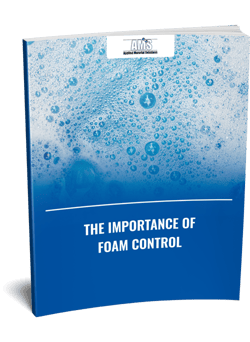How to Achieve Optimal Foam Control for Improved Production Effectiveness
Comprehending the Value of Foam Control in Industrial Processes
In commercial processes, foam control is often a forgotten yet important aspect that straight influences functional efficiency and item integrity. The visibility of excessive foam can lead to substantial challenges, consisting of disrupted blending and decreased response kinetics, which may inevitably affect item quality throughout various fields such as pharmaceuticals and food production.

The Duty of Foam in Industry
Foam plays a significant function in various industrial processes, influencing both performance and product quality. In fields such as food and beverage, drugs, and petrochemicals, foam can serve both advantageous and detrimental objectives. For instance, in the food market, foam stabilization is vital during procedures like light whipping cream or generating beer, where the quality of foam straight impacts consumer assumption and product features.
In chemical manufacturing, foam can work as a barrier, stopping the correct mixing of reagents, which can result in suboptimal yields and insufficient responses. Conversely, in processes like flotation protection in mineral handling, foam is utilized to separate useful minerals from waste product, enhancing recovery rates.
Additionally, in wastewater therapy, foam development can indicate the presence of organic issue, offering as an essential parameter for process monitoring. The capability to manage foam is crucial for maintaining process stability and optimizing operational expenses. Comprehending the function of foam in commercial applications enables drivers and designers to carry out reliable foam monitoring approaches, making certain that foam adds favorably to total procedure efficiency while lessening its possible downsides.
Typical Difficulties of Foam Formation
Numerous markets deal with significant challenges due to the unintended development of foam throughout different processes. Foam can disrupt the efficiency of procedures, bring about raised downtime and greater operational costs. In sectors such as drugs, food and drink, and wastewater treatment, foam can hinder blending, minimize product yield, and make complex separation processes.
Moreover, foam can develop security risks by obstructing clear presence, which is important in atmospheres where precise dimensions and tracking are necessary. The visibility of foam can likewise bring about devices damage, as too much pressure buildup might occur in containers and reactors.
Additionally, the demand for regular treatment to handle foam can draw away resources and labor, ultimately impacting productivity. Ecological policies posture one more obstacle, as extreme foam can bring about non-compliance problems in effluent discharge, demanding extra therapy processes.
Influence on Product High Quality

In chemical production, foam can hinder reaction kinetics by limiting gas-liquid contact, causing insufficient reactions and lower returns. This not only affects the performance of production however can additionally result in low-grade final product that do not meet regulative criteria or customer specs.
In addition, in pharmaceuticals, foam formation my response during formula procedures can present air bubbles into sensitive compounds, jeopardizing medicine efficiency and stability. In addition, foam can trigger operational problems such as overflow and tools breakdowns, increasing downtime and maintenance costs, even more impacting item top quality and uniformity.
Strategies for Effective Foam Control
Dealing with the difficulties presented by foam is crucial for keeping item top quality throughout numerous commercial fields. Reliable foam control approaches are important to mitigate the adverse effects of foam formation, which can disrupt procedures and concession item stability.
One of the primary techniques involves the selection and application of appropriate antifoaming representatives. These representatives are created to minimize surface tension and inhibit bubble development, and their efficiency can vary based on the specific procedure problems. Routine monitoring of foam degrees is critical to make certain prompt intervention, allowing drivers to apply antifoaming agents prior to foam ends up being a considerable issue.
In addition, enhancing process criteria such as temperature level and agitation can play a crucial duty in foam click here to read administration. Decreasing frustration intensity or adjusting feed prices can reduce foam generation. Applying mechanical foam control gadgets, such as foam breakers or defoamers, can also give efficient remedies for high-foaming applications.
Training personnel on foam administration techniques and the relevance of maintaining optimum operating conditions better enhances foam control initiatives. Foam Control. By employing a mix of these strategies, markets can effectively handle foam, ensuring functional performance and preserving the top quality of their products
Future Fads in Foam Management
Exactly how will innovations in technology shape the future of foam administration in commercial procedures? The integration of synthetic knowledge (AI) and equipment learning will transform foam control methods, making it possible for real-time surveillance and adaptive reactions to foam formation. These innovations can examine functional criteria and historic information to forecast foam behavior, allowing for preemptive measures that enhance process efficiency.
Furthermore, the development of advanced foam control representatives, consisting of environmentally pleasant and bio-based choices, is obtaining grip. These technologies not just minimize foam yet likewise line up with sustainability goals, decreasing the environmental footprint of industrial procedures.
Automation will certainly likewise play a vital function, as automated foam control systems can optimize the dosage of defoamers based upon real-time dimensions, reducing waste and enhancing effectiveness.
Furthermore, the fostering of IoT (Web of Things) devices will certainly facilitate seamless communication in between devices and foam control Learn More systems, guaranteeing a holistic strategy to foam monitoring. (Foam Control)
Final Thought
Finally, reliable foam control is necessary for enhancing industrial procedures across numerous markets. The challenges postured by foam development can significantly influence product top quality and functional efficiency. Carrying out tactical foam monitoring methods, consisting of making use of antifoaming representatives and process optimization, mitigates these difficulties. As industries remain to evolve, continuous advancements in foam control innovations will additionally boost efficiency and sustainability, making certain compliance with ecological regulations while preserving the honesty of products.
In the food sector, foam stablizing is essential during procedures like whipping lotion or producing beer, where the quality of foam directly affects customer assumption and product qualities.
Comprehending the duty of foam in commercial applications permits engineers and operators to execute efficient foam monitoring approaches, ensuring that foam contributes positively to overall process performance while reducing its prospective disadvantages.
Routine tracking of foam degrees is vital to make certain prompt treatment, permitting drivers to use antifoaming representatives before foam ends up being a considerable problem.
Executing mechanical foam control gadgets, such as foam breakers or defoamers, can likewise offer effective solutions for high-foaming applications.
The integration of artificial intelligence (AI) and equipment understanding will certainly reinvent foam control methods, allowing real-time tracking and adaptive responses to foam development.